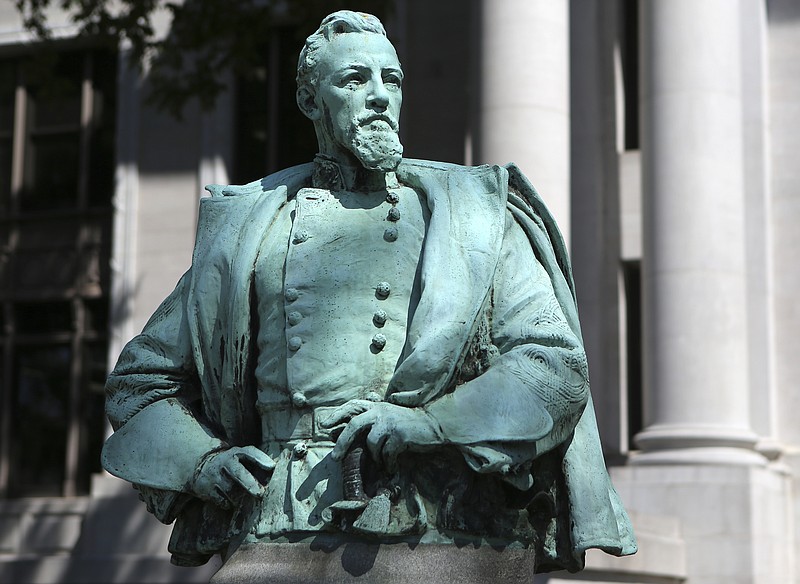It's good to see the Hamilton County Commission discussing - yes, actually discussing - whether to remove the bust of Confederate Lt. Gen Alexander P. Stewart from the Hamilton County Courthouse lawn.
Commissioner Greg Beck introduced a resolution to seek the Tennessee Historical Commission's approval to relocate the statue, calling for the Hamilton County Courthouse to stand as "neutral ground."
"This resolution speaks to the sentiments of the general public across the cultural divide, and transcends even district lines and party lines," said Beck, who is black. "It presents this commission with a moment of greatness."
Of course, there seem to be as many different opinions about what should happen now as there are county commissioners - nine.
Greg Martin says decisions made by 19th century Americans shouldn't be viewed through a 21st century lens: "I don't agree with his [Stewart's] religion, I don't agree with his politics and I certainly didn't agree with the war that he fought. But I do appreciate the general's service to the United States of America before and after the Civil War."
Tim Boyd says if the Confederate statue is removed, no other statue or memorial of any kind should take its place.
Commissioner Joe Graham asked for the commission to have more time to discuss the matter before it comes to a vote next Wednesday. "What bothers me about removing the bust, at least removing it right now, [is] I'm afraid we're letting our emotions react to what's going on in America around us."
This discussion is good. More is better. And when that discussion is done, action is best of all.
To be sure, the history of A.P. Stewart and how his statue wound up on our courthouse square is not as clear-cut as similar debates on Robert E. Lee and Nathan Bedford Forest - both slave owners.
Alexander "A.P." Stewart wasn't a Chattanooga son, nor did he embody the old slave-owning stereotype of the Confederacy (though his biographers say he steadfastly believed blacks were inferior). He did fight in the Battle of Chickamauga and most of the other major Civil War battles. But defenders of the statue say his main claim on that little dot of courthouse ground is that he was instrumental in the late 1890s and early 1900s - long after the war - in planning and creating the nation's first military park here. In doing so, he was part of an effort to mend our divides.
Here's the rub - or rubs: Two men were appointed civilian "commissioners" to create the park, a former Union man, Gen. Joseph S. Fullerton, and Stewart, a former Confederate. Years later, the local chapter of the Daughters of the Confederacy, also named for Stewart, paid for the statue and had it placed at the courthouse in 1919.
But there's no balancing statue of Fullerton there. Stewart's statue is garbed in a Confederate uniform, not the civilian clothes he wore to oversee the building of the park, and the wording on the statue makes no mention of the park or of anything other than "Old A.P.'s" Confederate service.
Further, the timing of the statue's placement coincides with a dark period in our history when Confederate statues began going up all over the South to remind right blacks "of their place." It was after the Plessy v. Ferguson Supreme Court case established the "separate but equal" doctrine that gave rise to both Jim Crow laws and the formation of the NAACP. Another influence was the "nationalism" movement following the first World War - that's also about the time the Klan made a comeback as the "Invisible Empire." The statues were quiet, but in-your-face, symbols of white supremacy.
Commissioner Beck got it just right when he said Stewart's portrayal in Confederate uniform is a core issue, no matter what greatness he achieved with the Chickamauga and Chattanooga National Military Park.
"We have to be careful how we try to paint a good sign on a bad uniform," he said. "We have to be careful how we do that. That has happened over and over."
The Chattanooga chapter of the NAACP has pushed for the bust's removal since July, following a similar movement across the country after the tragic mass church shooting in Charleston, S.C., by white supremacist Dylann Roof in 2015.
And in August it became crystal clear why we have to have rational conversations to separate whitewashed history from real history: An Aug. 12 Charlottesville, Va., demonstration by white nationalists and white supremacists against removing statues turned violent and a woman was killed when a man known to have had a fondness for Nazis deliberately rammed a car into a group of counterprotesters.
Dialogue - not whitewashing and not violence - widens understanding.
Our history is our history, warts and all. But our todays and our future days don't have to be whitewashed, warty and certainly not bloody.
There is no shame in righting wrongs. A.P Stewart, himself, made a point of that.
If he were alive today, he'd probably be the first to say we shouldn't let his Confederate likeness beside our courthouse remain a continuing burr in our community.
